Notes: Weston Rhyn was located on the Shrewsbury & Chester Railway (S&CR) which opened throughout on 14 October 1848. The S&CR was formed in July 1846 out of a merger of the North Wales Mineral Railway (NWMR) and the Shrewsbury, Oswestry & Chester Junction Railway (SO&CJR). The NWMR had started the construction of a line between Saltney Junction (near Chester) and Ruabon via Wrexham in 1844. The SO&CJR was set up to create a route between Shrewsbury and Chester and the merger enabled that task to be carried out through an extension of the NWMR line. The first section of the line opened between Saltney Junction and a temporary railhead at Rhosymedre on 4 November 1846.
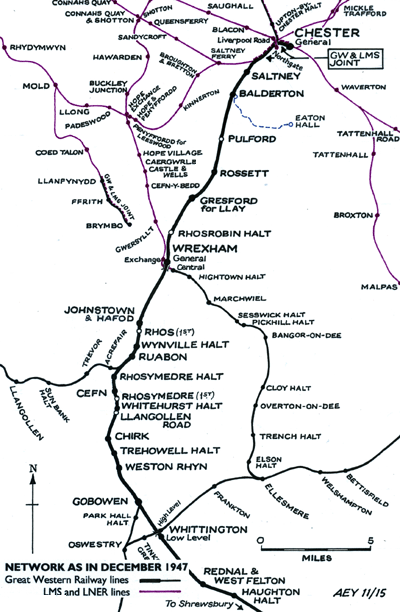 The station opened as Presgwyn when the line was completed on 14 October 1848. It was located on the south side of the Weston Rhyn and Rhoswiel road which crossed the line via a level crossing. The station opened as Presgwyn when the line was completed on 14 October 1848. It was located on the south side of the Weston Rhyn and Rhoswiel road which crossed the line via a level crossing.
The station building was on the down side (Chester direction) of the double track line adjacent to the level crossing. Like other stations on the line it was the work of Chester architect, T M Penson, and was in a Tudor cottage ornée style. Built of stone, the two-storey building was given two asymmetrical gables facing the railway, the larger (southern) gable standing forward and possessing a canted bay window on the ground floor. One gable faced the road and another was on the west side of the building. Heavy decorated bargeboards with finials and pendants embellished the gables; although on photographs a plain bargeboard is seen on the gable facing the road, it probably replaced one of the decorated design. A short single-storey wing extended north of the two-storey building. At the time of opening there would have been only simple low level platforms.
Goods sidings were provided to the south of the station on the east side of the line.
Presgwyn was served by trains between Shrewsbury and Chester and also those serving the Oswestry branch. The March 1850 timetable showed four up and five down trains on Monday-to-Saturday. The destination of three of the up trains was Shrewsbury and the other terminated at Oswestry. All of the down trains went to Chester. There were two trains in each direction on Sunday.
On 1 September 1854 the S&CR was taken over by the Great Western Railway (GWR). The GWR considered Presgwyn to be unremunerative and closed the station in March 1855.To read more about the S&C and the GWR take over click here.
Under the GWR the line through Presgwyn became a busy trunk railway that carried express and local passenger trains and large volumes of freight. A Birmingham – Birkenhead express service was introduced on 1 May 1857 and a London Paddington – Birkenhead service on 1 October 1861. These were prestigious trains that called only at principal stations.
Around 1860 Preesgwyn colliery opened a short distance north-east of the station site. A branch line was opened to serve the colliery from a junction with the main line north of the level crossing.
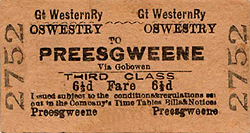 In November 1871 the station was reopened as Preesgweene. It is likely that it was at this time that platforms were added. They were constructed from brick and a brick pent-roof enclosed shelter was provided on the up side. Its roof sloped upwards towards the railway and a small canopy continued the angle of the roof; a serrated valance was provided. On the down side new ticket office and waiting facilities were provided immediately south of the original building. They were housed in a single-storey brick structure, and because this was adapted to the new, higher platform is stood at a higher level than the original single-storey wing; however, because the pitch of its roof was gentler than the older building their roof ridges were at a similar height. The window and door openings on the new structures had elliptical arches rather than the flat lintels seen on the old building. In November 1871 the station was reopened as Preesgweene. It is likely that it was at this time that platforms were added. They were constructed from brick and a brick pent-roof enclosed shelter was provided on the up side. Its roof sloped upwards towards the railway and a small canopy continued the angle of the roof; a serrated valance was provided. On the down side new ticket office and waiting facilities were provided immediately south of the original building. They were housed in a single-storey brick structure, and because this was adapted to the new, higher platform is stood at a higher level than the original single-storey wing; however, because the pitch of its roof was gentler than the older building their roof ridges were at a similar height. The window and door openings on the new structures had elliptical arches rather than the flat lintels seen on the old building.
In 1880 a signal box was opened on the north side of the level crossing east of the line. It was a Mackenzie & Holland box with a brick base and timber upper cabin.
The December 1895 timetable showed five trains in each direction on Monday-to-Saturday. The first up train of the day at 9.12am ran to Wolverhampton Low Level but the other four travelled only to Shrewsbury. The down trains all ran to Chester. On Sunday there were two trains in each direction. One of the up trains ran to London Paddington and the other to Solihull. The down trains ran to Chester.
By 1902 Preesgwyn colliery had closed but the branch was left in situ.
In 1903 17,364 passenger tickets were sold at Preesgweene and 4,869 parcels were handled. General goods forwarded amounted to 273 tons with 2,459 being received.
The year 1913 was a busy one for the station with 33,477 passenger tickets being sold - nearly double the figure of ten years earlier. The station also handled 19,743 parcels. It forwarded 312 tons of goods and received 2,042.
-owestry(gwpn).gif) In 1921 a new colliery was opened at Ifton, two miles east of the station. A branch was built to connect the colliery to the main line north of the station via newly installed exchange sidings. All trace of the previous branch line to Preesgwyn Colliery was swept away. Locomotive sheds for the colliery branch engines were built alongside the exchange sidings. In 1921 a new colliery was opened at Ifton, two miles east of the station. A branch was built to connect the colliery to the main line north of the station via newly installed exchange sidings. All trace of the previous branch line to Preesgwyn Colliery was swept away. Locomotive sheds for the colliery branch engines were built alongside the exchange sidings.
By July 1922 Preesgweene had 12 up and eight down trains on Monday-to-Saturday. There was an additional down train on Wednesday and two in each direction on Sunday.
The signal box was rebuilt in 1924 presumably because of the addition of the Ifton Colliery exchange sidings. Around this time additional sidings were also provided in the goods yard and a goods shed was constructed: a prefabricated structure with a curved roof.
In 1933 31,263 passenger tickets were sold, a slight drop from the 1913 figure but much less of a decline than was experienced at some of the other stations on the line where competition with buses was felt.
In 1935 Preesgweene station was renamed Weston Rhyn by the GWR.
On 1 January 1948 Weston Rhyn became part of the British Railways [Western Region] (BR[WR]). The BR timetable for the summer of 1949 showed nine trains in each direction as seen in the table below. On Sunday there were three up and two down services.
Up Trains – Summer 1949 |
Destination |
Down Trains – Summer 1949 |
Destination |
7.03am |
Oswestry |
7.48am |
Ruabon |
8.23am |
Shrewsbury |
8.32am |
Chester |
9.50am |
Oswestry |
10.55am |
Wrexham |
12.09pm |
Gobowen |
12.52pm |
Wrexham |
2.34pm |
Shrewsbury |
2.30pm |
Chester |
4.36pm |
Oswestry |
5.45pm |
Chester |
6.09pm |
Gobowen |
7.38pm |
Wrexham |
7.20pm |
Birmingham Snow Hill |
9.12pm |
Wrexham |
8.24pm |
Gobowen |
10.04pm |
Wrexham |
The 1956 Handbook of Stations showed Weston Rhyn station as handling only passengers and parcels. It showed National Coal Board (NCB) facilities that included the exchange sidings, the branch line and a wagon repair shop.
The 15 September 1958 timetable showed only seven up and four down services on Monday-to-Saturday. There was no Sunday service.
On 12 September 1960 BR[WR] withdrew the passenger service from Weston Rhyn at the same time as many other stations on this line. Demolition of the up platform had begun by 1962.
.gif) From 1 January 1963 Weston Rhyn came under the operational control of British Railways [London Midland Region] (BR[LMR]) and was transferred fully to this region on 1 July 1963. BR[LMR] closed the station to goods services on 4 November 1963. From 1 January 1963 Weston Rhyn came under the operational control of British Railways [London Midland Region] (BR[LMR]) and was transferred fully to this region on 1 July 1963. BR[LMR] closed the station to goods services on 4 November 1963.
The platforms had been completely demolished by September 1965.
In 1969 Ifton Colliery closed; the branch and the exchange sidings were lifted shortly afterwards. The goods loops remained in use until 1991. Weston Rhyn signal box was closed on 3 August 1991 and demolished after October 1991.
By 2015, although the platforms at Weston Rhyn had been demolished the original building dating from 1848 was extant and in use as a private residence. The prefabricated goods shed was also extant.
To see more information about Weston Rhyn signal box click here
To see information about the Ifton Colliery branch click here
Tickets from Michael Stewart and route map by Alan Young
Sources:
- A Regional History of the Railways of Great Britain - Volume II North & Mid Wales - Peter E Baughan - David & Charles 1980.
- Encyclopaedia of British Railway Companies - Christopher Awdry - Guild Publishing 1990.
- Paddington to the Mersey - Dr R. Preston Hendry & R. Powell Hendry - Oxford Publishing Company 1992.
- Railway Passenger Stations in Great Britain - a Chronology - Michael Quick - Railway & Canal Historical Society 2009.
- Shrewsbury to Chester - Vic Mitchell & Keith Smith - Middleton Press 2010.
To see the
other stations on the Shrewsbury - Chester General line
click on the station name: Shrewsbury S&C, Leaton, Oldwoods Halt, Baschurch,
Stanwardine Halt, Haughton Halt, Rednal & West Felton, Whittington Low Level, Whitehurst Halt, Rhosymedre, Cefn, Rhosymedre Halt, Wynnville Halt, Rhos, Johnstown & Hafod, Rhosrobin Halt, Gresford, Rossett,
Pulford, Balderton and Saltney |

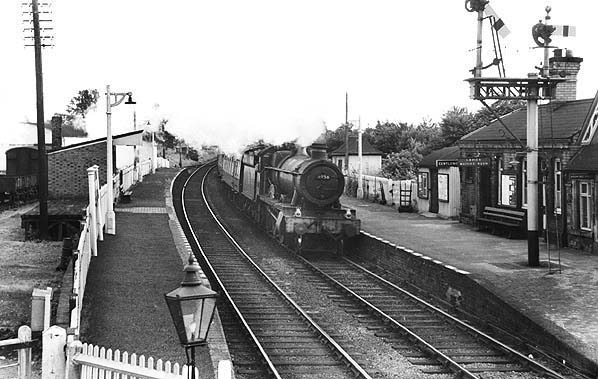
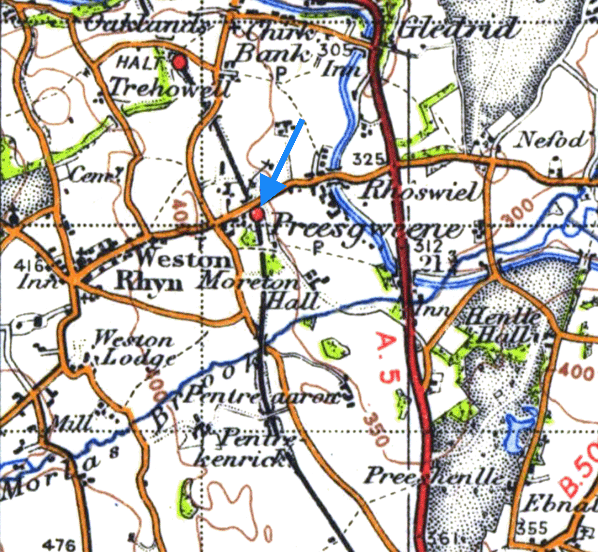
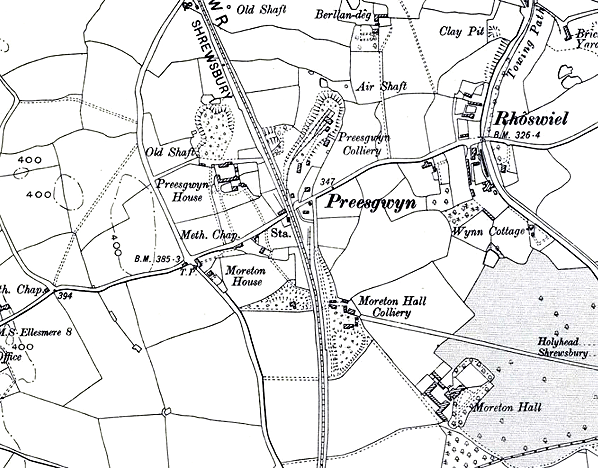
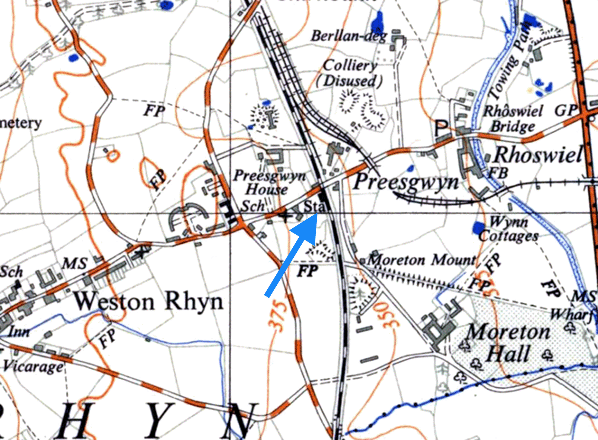
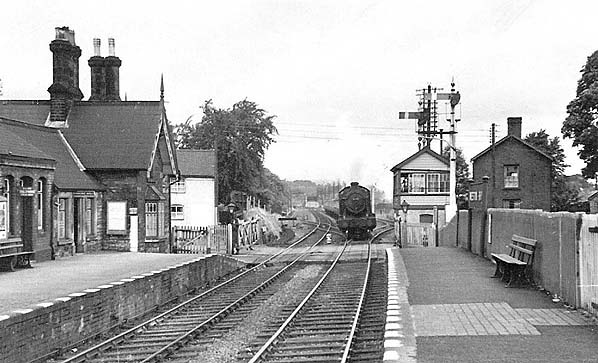
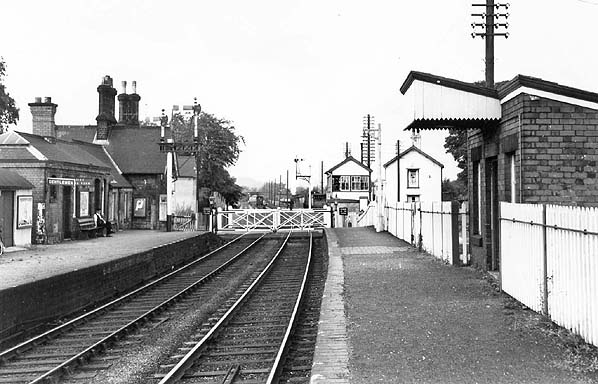
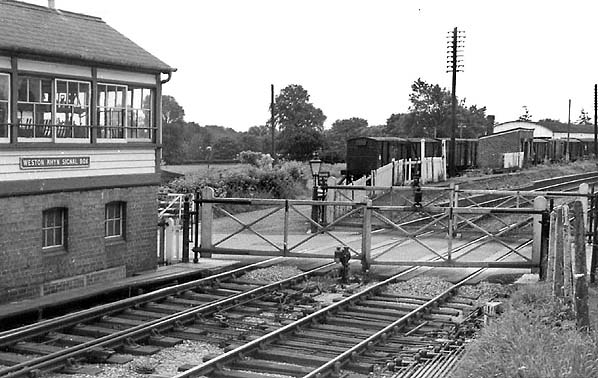
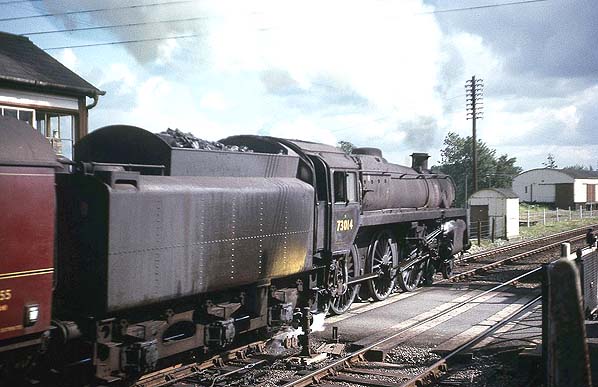
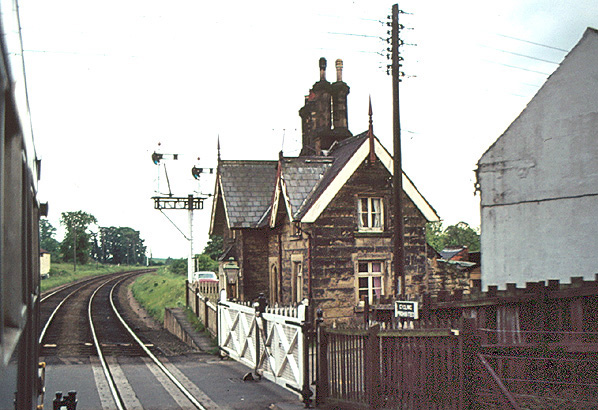
.jpg)
 The station opened as Presgwyn when the line was completed on 14 October 1848. It was located on the south side of the Weston Rhyn and Rhoswiel road which crossed the line via a level crossing.
The station opened as Presgwyn when the line was completed on 14 October 1848. It was located on the south side of the Weston Rhyn and Rhoswiel road which crossed the line via a level crossing.  In November 1871 the station was reopened as Preesgweene. It is likely that it was at this time that platforms were added. They were constructed from brick and a brick pent-roof enclosed shelter was provided on the up side. Its roof sloped upwards towards the railway and a small canopy continued the angle of the roof; a serrated valance was provided. On the down side new ticket office and waiting facilities were provided immediately south of the original building. They were housed in a single-storey brick structure, and because this was adapted to the new, higher platform is stood at a higher level than the original single-storey wing; however, because the pitch of its roof was gentler than the older building their roof ridges were at a similar height. The window and door openings on the new structures had elliptical arches rather than the flat lintels seen on the old building.
In November 1871 the station was reopened as Preesgweene. It is likely that it was at this time that platforms were added. They were constructed from brick and a brick pent-roof enclosed shelter was provided on the up side. Its roof sloped upwards towards the railway and a small canopy continued the angle of the roof; a serrated valance was provided. On the down side new ticket office and waiting facilities were provided immediately south of the original building. They were housed in a single-storey brick structure, and because this was adapted to the new, higher platform is stood at a higher level than the original single-storey wing; however, because the pitch of its roof was gentler than the older building their roof ridges were at a similar height. The window and door openings on the new structures had elliptical arches rather than the flat lintels seen on the old building.-owestry(gwpn).gif) In 1921 a new colliery was opened at Ifton, two miles east of the station. A branch was built to connect the colliery to the main line north of the station via newly installed exchange sidings. All trace of the previous branch line to Preesgwyn Colliery was swept away. Locomotive sheds for the colliery branch engines were built alongside the exchange sidings.
In 1921 a new colliery was opened at Ifton, two miles east of the station. A branch was built to connect the colliery to the main line north of the station via newly installed exchange sidings. All trace of the previous branch line to Preesgwyn Colliery was swept away. Locomotive sheds for the colliery branch engines were built alongside the exchange sidings. .gif) From 1 January 1963 Weston Rhyn came under the operational control of British Railways [London Midland Region] (BR[LMR]) and was transferred fully to this region on 1 July 1963. BR[LMR] closed the station to goods services on 4 November 1963.
From 1 January 1963 Weston Rhyn came under the operational control of British Railways [London Midland Region] (BR[LMR]) and was transferred fully to this region on 1 July 1963. BR[LMR] closed the station to goods services on 4 November 1963. 
 Home Page
Home Page